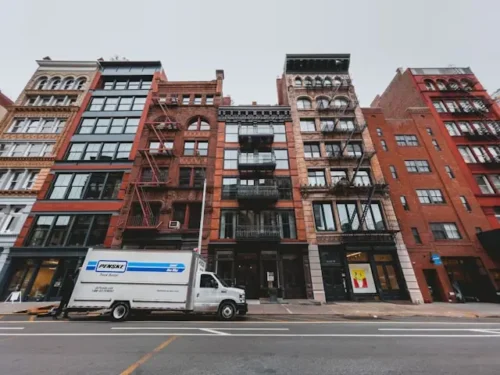
Creating a Moving Budget: What to Expect and How to Save
Are you planning a move—perhaps to New York City? It’s an exciting venture, but creating a moving budget is critical to ensure your transition to the Big Apple is smooth and stress-free. This guide will walk you through the essentials of budgeting for your move, from understanding costs to smart saving tips. Let’s make your dream a reality without breaking the bank.
Understanding the Basics of Moving Costs in NYC
Moving to New York is unlike relocating to any other place. The city’s unique vibe comes with its own set of moving challenges and costs.
Rent
Renting a place often requires a significant deposit. Usually, you might need to pay the first month’s rent plus a security deposit upfront. This security deposit is typically the same amount as one month’s rent. So, if your rent is $2,000, prepare to have $4,000 ready for these initial costs.
The Move
Hiring a moving company in the city varies widely in cost. Factors like the distance of your move, number of belongings, and time of year all play a role. It’s not just about picking a truck; it’s about understanding the service you’re getting. Some companies offer full services, including packing and unpacking, while others might just offer transportation.
NYC’s streets add a layer of complexity to moving. You might need to consider parking permits for moving trucks or additional fees for moving items through narrow or busy streets. Remember, time is money, especially in a city that never sleeps. Delays caused by traffic or parking issues can add to your costs. Understanding these basic costs sets the stage for a well-planned, financially manageable move to New York City. With this knowledge, you’re one step closer to making your NYC dream a reality.
Creating a Moving Budget: A Step-by-Step Guide
In order to avoid surprises and manage expenses effectively, creating a moving budget for your NYC relocation is crucial. Let’s break it down into manageable steps:
- Start by gathering quotes from various moving companies. Consider local options, like U.Santini Moving and Storage Brooklyn, New York, to better understand the range of services and prices available. For instance, U.Santini has performed over thirty thousand moves and has been in the business for over ninety years—that’s a pretty great track record! But on top of their success, they also offer competitive rates with no hidden fees. Compare these quotes carefully, looking at the cost and what’s included in each service.
- Bear in mind that transportation costs can vary, especially in a metropolis. If you rent a truck, factor in rental rates, gas, and parking fees. For professional movers, consider their rates, including any extra charges for moving in high-traffic areas or navigating narrow streets.
- Don’t forget to budget for packing supplies like boxes, tape, and bubble wrap. These can add up quickly.
- Also, consider if you need insurance for your belongings during the move. This could be a wise investment, especially for valuable items.
Hidden Costs You Shouldn’t Ignore
While creating a moving budget, it’s easy to overlook some less obvious expenses. Whether you’re leaving an old apartment or moving into a new one, cleaning costs can sneak up on you. Some landlords require professional cleaning before returning your deposit, and you might want your new place cleaned before settling in.
Likewise, setting up utilities in your new home often involves fees. These can include deposits, installation charges, or initial service fees. Research these costs ahead of time to avoid surprises in your first month’s bills. Also, it’s wise to set aside some money for unexpected expenses—as hard as that might seem nowadays. Things like last-minute repairs, additional moving supplies, or unforeseen transportation costs can arise. Even the simple process of turning your house into a home might be costlier than expected. Having a cushion in your budget can be a lifesaver.
Smart Saving Strategies for Your Move
Cutting costs on your NYC move requires clever tactics. Take a look at some of our favorites.
Save When Packing
To start with, reduce your load before you start packing. Sell, donate, or discard items you no longer need. Less stuff means fewer boxes and potentially lower moving costs. Instead of buying new boxes, find free ones at local supermarkets or community groups. Use newspapers, towels, or clothes as packing materials, saving on bubble wrap and packing peanuts.
Know When to Move
Moving during less busy times can save you money. Weekdays or mid-month dates often come with lower rates. Movers are busier on weekends and at the month’s end, so prices tend to be higher. Also, keep in mind that during certain times of the year, like holidays, some streets might be very crowded or even blocked. Along with that, consider packing your belongings yourself. This can significantly cut costs. You can find affordable packing materials or even get boxes for free from local stores. Be sure to label everything clearly to ease unpacking.
Divide and Conquer
If you’re only moving a few items, consider using NYC’s public transport system. It’s much cheaper than hiring a moving van for small loads. These strategies save money and add efficiency, helping you stay organized during the moving process. A lighter load and creative packing solutions can greatly impact your moving budget.

Being Smart with Your Money
Moving to New York is just the start. Once you’re there, you must stretch your budget. Here is how:
- Explore neighborhoods that offer a balance of affordability and convenience. Areas like Astoria or Sunset Park can be less expensive than Manhattan but still offer great amenities and accessibility
- Keep a close eye on your daily spending
- Opt for cooking at home over eating out.
- Use public transportation instead of taxis or ride-shares
- Enjoy parks, free museum days, and public events. This not only saves money but enriches your city living experience
- Don’t skip on insurance to save money. If something goes wrong, you could face larger losses
- Plan ahead to find the best deals and avoid rush fees
Read More: How To Use Car Shipping Services To Facilitate Your Family Move
Conclusion
Creating a moving budget is fundamental for a smooth transition. It helps you navigate the financial aspects of relocating so that you’re prepared for both expected and unexpected costs. By researching, planning, and employing smart saving strategies, you can make your move to the Big Apple exciting and affordable. Keep these tips in mind, and you’ll be well on your way to a successful new chapter in New York City.

